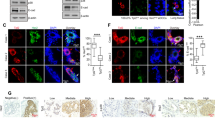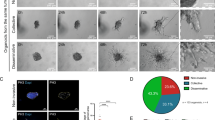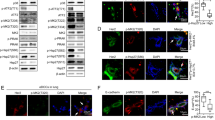Abstract
Tumor progression is a complex, multistep process involving accumulation of genetic aberrations and alterations in gene expression patterns leading to uncontrolled cell division, invasion into surrounding tissue and finally dissemination and metastasis. We have previously shown that the Arg/Abl2 non-receptor tyrosine kinase acts downstream of the EGF receptor and Src tyrosine kinases to promote invadopodium function in breast cancer cells, thereby promoting their invasiveness. However, whether and how Arg contributes to tumor development and dissemination in vivo has never been investigated. Using a mouse xenograft model, we show that knocking down Arg in breast cancer cells leads to increased tumor cell proliferation and significantly enlarged tumor size. Despite having larger tumors, the Arg-knockdown (Arg KD) tumor-bearing mice exhibit significant reductions in tumor cell invasion, intravasation into blood vessels and spontaneous metastasis to lungs. Interestingly, we found that proliferation-associated genes in the Ras-MAPK (mitogen-activated protein kinase) pathway are upregulated in Arg KD breast cancer cells, as is Ras-MAPK signaling, while invasion-associated genes are significantly downregulated. These data suggest that Arg promotes tumor cell invasion and dissemination, while simultaneously inhibiting tumor growth. We propose that Arg acts as a switch in metastatic cancer cells that governs the decision to ‘grow or go’ (divide or invade).
This is a preview of subscription content, access via your institution
Access options
Subscribe to this journal
Receive 50 print issues and online access
$259.00 per year
only $5.18 per issue
Buy this article
- Purchase on Springer Link
- Instant access to full article PDF
Prices may be subject to local taxes which are calculated during checkout





Similar content being viewed by others
References
Hanahan D, Weinberg RA . The hallmarks of cancer. Cell 2000; 100: 57–70.
Hanahan D, Weinberg RA . Hallmarks of cancer: the next generation. Cell 2011; 144: 646–674.
Wang W, Goswami S, Sahai E, Wyckoff JB, Segall JE, Condeelis JS . Tumor cells caught in the act of invading: their strategy for enhanced cell motility. Trends Cell Biol 2005; 15: 138–145.
Nguyen DX, Bos PD, Massague J . Metastasis: from dissemination to organ-specific colonization. Nat Rev Cancer 2009; 9: 274–284.
Bradley WD, Koleske AJ . Regulation of cell migration and morphogenesis by Abl-family kinases: emerging mechanisms and physiological contexts. J Cell Sci 2009; 122 (Part 19): 3441–3454.
Pendergast AM . The Abl family kinases: mechanisms of regulation and signaling. Adv Cancer Res 2002; 85: 51–100.
Derkinderen P, Scales TM, Hanger DP, Leung KY, Byers HL, Ward MA et al. Tyrosine 394 is phosphorylated in Alzheimer’s paired helical filament tau and in fetal tau with c-Abl as the candidate tyrosine kinase. J Neurosci 2005; 25: 6584–6593.
Backert S, Feller SM, Wessler S . Emerging roles of Abl family tyrosine kinases in microbial pathogenesis. Trends Biochem Sci 2008; 33: 80–90.
Newsome TP, Weisswange I, Frischknecht F, Way M . Abl collaborates with Src family kinases to stimulate actin-based motility of vaccinia virus. Cell Microbiol 2006; 8: 233–241.
Advani AS, Pendergast AM . Bcr-Abl variants: biological and clinical aspects. Leuk Res 2002; 26: 713–720.
Cazzaniga G, Tosi S, Aloisi A, Giudici G, Daniotti M, Pioltelli P et al. The tyrosine kinase abl-related gene ARG is fused to ETV6 in an AML-M4Eo patient with a t(1;12)(q25;p13): molecular cloning of both reciprocal transcripts. Blood 1999; 94: 4370–4373.
Iijima Y, Ito T, Oikawa T, Eguchi M, Eguchi-Ishimae M, Kamada N et al. A new ETV6/TEL partner gene, ARG (ABL-related gene or ABL2), identified in an AML-M3 cell line with a t(1;12)(q25;p13) translocation. Blood 2000; 95: 2126–2131.
McWhirter JR, Wang JY . Activation of tyrosinase kinase and microfilament-binding functions of c-abl by bcr sequences in bcr/abl fusion proteins. Mol Cell Biol 1991; 11: 1553–1565.
Chopra R, Pu QQ, Elefanty AG . Biology of BCR-ABL. Blood Rev 1999; 13: 211–229.
Rikova K, Guo A, Zeng Q, Possemato A, Yu J, Haack H et al. Global survey of phosphotyrosine signaling identifies oncogenic kinases in lung cancer. Cell 2007; 131: 1190–1203.
Podtcheko A, Ohtsuru A, Tsuda S, Namba H, Saenko V, Nakashima M et al. The selective tyrosine kinase inhibitor, STI571, inhibits growth of anaplastic thyroid cancer cells. J Clin Endocrinol Metab 2003; 88: 1889–1896.
Ganguly SS, Fiore LS, Sims JT, Friend JW, Srinivasan D, Thacker MA et al. c-Abl and Arg are activated in human primary melanomas, promote melanoma cell invasion via distinct pathways, and drive metastatic progression. Oncogene 2012; 31: 1804–1816.
Chen WS, Kung HJ, Yang WK, Lin W . Comparative tyrosine-kinase profiles in colorectal cancers: enhanced arg expression in carcinoma as compared with adenoma and normal mucosa. Int J Cancer 1999; 83: 579–584.
Crnogorac-Jurcevic T, Efthimiou E, Nielsen T, Loader J, Terris B, Stamp G et al. Expression profiling of microdissected pancreatic adenocarcinomas. Oncogene 2002; 21: 4587–4594.
Sirvent A, Benistant C, Roche S . Cytoplasmic signalling by the c-Abl tyrosine kinase in normal and cancer cells. Biol Cell 2008; 100: 617–631.
Srinivasan D, Plattner R . Activation of Abl tyrosine kinases promotes invasion of aggressive breast cancer cells. Cancer Res 2006; 66: 5648–5655.
Srinivasan D, Sims JT, Plattner R . Aggressive breast cancer cells are dependent on activated Abl kinases for proliferation, anchorage-independent growth and survival. Oncogene 2008; 27: 1095–1105.
Smith-Pearson PS, Greuber EK, Yogalingam G, Pendergast AM . Abl kinases are required for invadopodia formation and chemokine-induced invasion. J Biol Chem 2010; 285: 40201–40211.
Mader CC, Oser M, Magalhaes MA, Bravo-Cordero JJ, Condeelis J, Koleske AJ et al. An EGFR-Src-Arg-cortactin pathway mediates functional maturation of invadopodia and breast cancer cell invasion. Cancer Res 2011; 71: 1730–1741.
Brenton JD, Carey LA, Ahmed AA, Caldas C . Molecular classification and molecular forecasting of breast cancer: ready for clinical application? J Clin Oncol 2005; 23: 7350–7360.
Wyckoff JB, Segall JE, Condeelis JS . The collection of the motile population of cells from a living tumor. Cancer Res 2000; 60: 5401–5404.
Patsialou A, Wyckoff J, Wang Y, Goswami S, Stanley ER, Condeelis JS . Invasion of human breast cancer cells in vivo requires both paracrine and autocrine loops involving the colony-stimulating factor-1 receptor. Cancer Res 2009; 69: 9498–9506.
Wyckoff JB, Jones JG, Condeelis JS, Segall JE . A critical step in metastasis: in vivo analysis of intravasation at the primary tumor. Cancer Res 2000; 60: 2504–2511.
Gupta GP, Nguyen DX, Chiang AC, Bos PD, Kim JY, Nadal C et al. Mediators of vascular remodelling co-opted for sequential steps in lung metastasis. Nature 2007; 446: 765–770.
Whitfield ML, George LK, Grant GD, Perou CM . Common markers of proliferation. Nat Rev Cancer 2006; 6: 99–106.
Wang W, Goswami S, Lapidus K, Wells AL, Wyckoff JB, Sahai E et al. Identification and testing of a gene expression signature of invasive carcinoma cells within primary mammary tumors. Cancer Res 2004; 64: 8585–8594.
Wang W, Wyckoff JB, Goswami S, Wang Y, Sidani M, Segall JE et al. Coordinated regulation of pathways for enhanced cell motility and chemotaxis is conserved in rat and mouse mammary tumors. Cancer Res 2007; 67: 3505–3511.
Greene FL, Balch CM, Haller DG, Morrow M . AJCC Cancer Staging Manual 6th edn. Springer, Chicago, IL, 2002.
Minn AJ, Gupta GP, Siegel PM, Bos PD, Shu W, Giri DD et al. Genes that mediate breast cancer metastasis to lung. Nature 2005; 436: 518–524.
Minn AJ, Gupta GP, Padua D, Bos P, Nguyen DX, Nuyten D et al. Lung metastasis genes couple breast tumor size and metastatic spread. Proc Natl Acad Sci USA 2007; 104: 6740–6745.
Allington TM, Galliher-Beckley AJ, Schiemann WP . Activated Abl kinase inhibits oncogenic transforming growth factor-beta signaling and tumorigenesis in mammary tumors. FASEB J 2009; 23: 4231–4243.
Wo JY, Chen K, Neville BA, Lin NU, Punglia RS . Effect of very small tumor size on cancer-specific mortality in node-positive breast cancer. J Clin Oncol 2011; 29: 2619–2627.
Sawyers CL, McLaughlin J, Goga A, Havlik M, Witte O . The nuclear tyrosine kinase c-Abl negatively regulates cell growth. Cell 1994; 77: 121–131.
Acknowledgements
We would like to thank the Einstein Histotechnology and Comparative Pathology Facility for their excellent service, and Dr Rani Sellers for helpful advice and suggestions. This work was supported by PHS grant CA133346 and an Exceptional Project Award from the Breast Cancer Alliance (AJK) and CA100324 (JSC).
Author information
Authors and Affiliations
Corresponding authors
Ethics declarations
Competing interests
The authors declare no conflict of interest.
Additional information
Supplementary Information accompanies the paper on the Oncogene website
Supplementary information
Rights and permissions
About this article
Cite this article
Gil-Henn, H., Patsialou, A., Wang, Y. et al. Arg/Abl2 promotes invasion and attenuates proliferation of breast cancer in vivo. Oncogene 32, 2622–2630 (2013). https://doi.org/10.1038/onc.2012.284
Received:
Revised:
Accepted:
Published:
Issue Date:
DOI: https://doi.org/10.1038/onc.2012.284
Keywords
This article is cited by
-
The presence of circulating genetically abnormal cells in blood predicts risk of lung cancer in individuals with indeterminate pulmonary nodules
BMC Pulmonary Medicine (2023)
-
A novel Pyk2-derived peptide inhibits invadopodia-mediated breast cancer metastasis
Oncogene (2023)
-
VNTR polymorphism in the breakpoint region of ABL1 and susceptibility to bladder cancer
BMC Medical Genomics (2021)
-
TIMP-2 secreted by monocyte-like cells is a potent suppressor of invadopodia formation in pancreatic cancer cells
BMC Cancer (2019)
-
Astaxanthin suppresses the metastasis of colon cancer by inhibiting the MYC-mediated downregulation of microRNA-29a-3p and microRNA-200a
Scientific Reports (2019)



